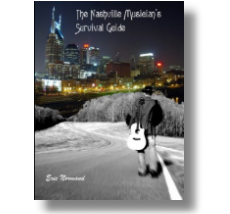
It’s now Saturday, May 8th, one week into this life changing event, and I find myself feeling still off balance, having difficulty focusing on some of life’s normal routines. The images of an ocean of brown murky water coming within a half-mile of our house, cars submerged on interstate lakes, and neighborhood houses underwater continue to work their way towards the front of my mind.
Last night I worked in a nightclub in Bellevue, a gig I’ve played countless times before. As a musician, I had been looking forward to a night of music with friends, hoping and expecting it would help return some of us to some kind of normalcy. It was the first time I’d seen these friends since before the flood, and it was pretty hard to talk about anything other than the weeks 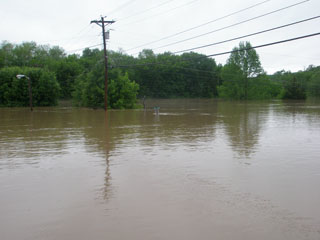 catastrophic events.
catastrophic events.
My friend Nick from Bellevue was home Saturday when the rain first began, and lost electricity sometime that night. On Sunday, still without electricity, he was unaware of what was going on, and decided to drive down to see an afternoon movie. As he approached the movie theater, he was horrified when he saw the entire building submerged in three or four feet of water. My friend Danny from Kingston Springs, lives on a Hill, and while his family and home are fine, some nearby houses had been washed away. He had also learned that the Harpeth River near his house, normally spanning 115 feet across, had swelled to a staggering 2900 feet in width. Another friend, Doug from Bellevue, said that his home was fine, but other homes nearby were damaged or destroyed. Doug works as a plumber, and revealed that he’s already been fixing water damaged boilers, and while he believes many units can be saved, he is hearing about some profiteers claiming all water damaged boilers need to be replaced. Yet another friend, Pam, also from Bellevue, told us of working at the now filled to capacity Microtel Inn, where her duties now include shuttling flood refugees back and forth from the hotel to local stores to buy bare essentials. Everybody I spoke to had been touched by this event in one way or another, and we are all feeling a deep sense of connection, as this new common ground we will forever now share.
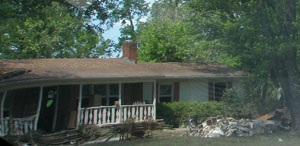 We started playing music around 7 PM, and the experience was almost surreal. I remember playing songs, yet feeling completely disconnected from the activity I was partaking in, almost as if I was watching myself from the other side of the room. The notes were all coming out right, but my mind was 1000 miles away, struggling to push back the images of horror that occupied my mind. The first 50 minute set seemed to happen in slow motion, with little reaction from the room full of somber patrons, eating their dinners and talking quietly. The night felt heavy and sluggish, and what is usually a warm-up set for our typically spirited group, felt more like a funeral march. Although the next set was more of the same, we were able to shake off some of this weight for the final part of the night, the music finally cutting through this dense air of disaster.
We started playing music around 7 PM, and the experience was almost surreal. I remember playing songs, yet feeling completely disconnected from the activity I was partaking in, almost as if I was watching myself from the other side of the room. The notes were all coming out right, but my mind was 1000 miles away, struggling to push back the images of horror that occupied my mind. The first 50 minute set seemed to happen in slow motion, with little reaction from the room full of somber patrons, eating their dinners and talking quietly. The night felt heavy and sluggish, and what is usually a warm-up set for our typically spirited group, felt more like a funeral march. Although the next set was more of the same, we were able to shake off some of this weight for the final part of the night, the music finally cutting through this dense air of disaster.
On the local news this morning, I learned that Hickman County, 50 miles southwest of Nashville, has been hit exceptionally hard by this flood, as over 100 bridges throughout the county have been crippled or destroyed. “The town of Centreville, and much of Hickman County, for four days, was an island unto itself, with no radio stations, no telephone service, AT&T or cellular, it was all out” stated Centreville’s mayor, Bob Bond. The county is still in emergency response mode, and thousands of feet of water line have been destroyed, rendering drinking water for the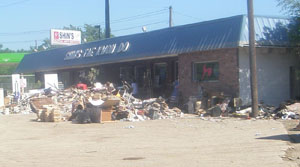 county’s 20,000 residents unsafe for the next 2 to 4 months.
county’s 20,000 residents unsafe for the next 2 to 4 months.
Another news story told of concern for some of Davidson county’s immigrant communities, where many are still residing in water drenched apartment complexes. Although officials are trying to get them to relocate to shelters, many won’t leave, as they will lose their jobs if they aren’t at their usual place of residence for daily transportation pickups.
These kinds of stories are expanding exponentially, and although my family and I haven’t been injured or lost any physical possessions, we have been forever changed. We feel exposed and vulnerable, with a strange state of uncertainty now deeply embedded in our psyche. Many others we have spoken to have shared similar sentiments. It’s almost as if we were raped, held down and pinned to the wall by a mysterious powerful force for which there was no defense. I can’t imagine the feelings held by those who have it much worse, losing homes, businesses, everything, some even losing their loved ones, and my heart goes out to them.
I know things will improve slowly over time, and hopefully there will be a return to some kind of normalcy in the weeks and months ahead. But it is likely to be a new kind of normalcy, because so much has changed. For once you have lived through an event of this magnitude, seeing the devastation firsthand, and hearing the stories of those suffering, you are forever changed. The time is now for the people of Tennessee to be strong, hold your heads up, and move forward with strength, conviction and unity. I believe the human spirit is strong, and if we open our hearts and minds, we can, and will survive.
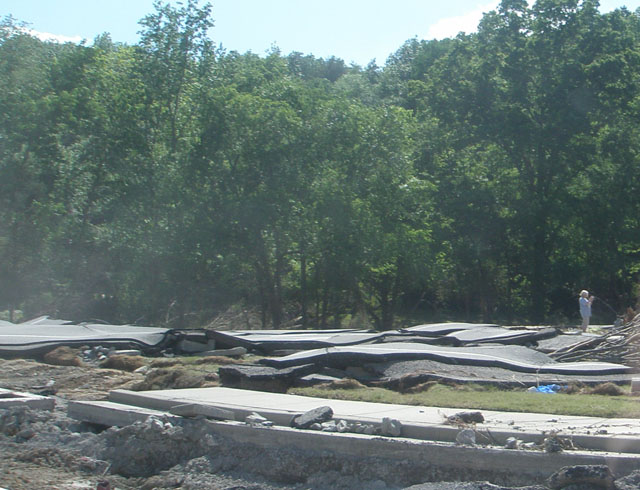
Wednesday, May 5th, marks day five of the Tennessee flood of 2010, and the story continues to unfold, with each new day giving larger perspective to the magnitude of this situation. This was the first day we had a chance to go out and see some of the damage firsthand, and what we saw is hard to put into words.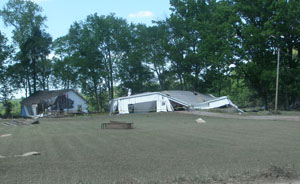
Several houses near the entrance to our development had received extensive water damage, their front yards looking like random flea markets of drying household items and furniture amidst dumpsters of debris and piles of water soaked carpet mounded on the lawns. An area about two or 3 miles further west on Highway 70 was exceptionally hard hit, with debris scattered across lawns amidst more piles of water soaked housewares. Several homes had received extensive structural damage, power lines were knocked down and laying on the street amidst broken asphalt, and a couple of concrete slabs revealed the location of houses that were swept away by the raging waters.
A couple hundred feet down the train tracks from the intersection of 249 And Hwy. 70, the force of water was massive enough to move 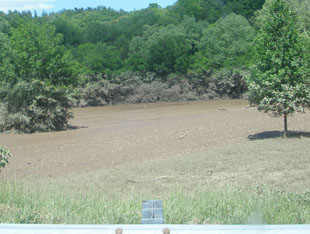 entire sections of railroad tracks 8 feet to one side, with steel spikes ejected and lying on the ground amidst the giant steel rails, now concave and still connected to the ties. Just past the train tracks onto 249 heading towards Kingston Springs, the water line on the trees was 10 to 12 feet high, despite being a couple hundred feet from the Harpeth River, which normally flows about 15 feet below the plain.
entire sections of railroad tracks 8 feet to one side, with steel spikes ejected and lying on the ground amidst the giant steel rails, now concave and still connected to the ties. Just past the train tracks onto 249 heading towards Kingston Springs, the water line on the trees was 10 to 12 feet high, despite being a couple hundred feet from the Harpeth River, which normally flows about 15 feet below the plain.
Further down 249, just past the Kingston Springs high school, a large section of the road had been ripped up, with gigantic slabs of asphalt protruding in every direction, similar to road damage more typically associated with an earthquake. On Harpeth View Trail, a side street just past the middle school, a family could be seen sitting on the cement slab where their house once stood, one of several 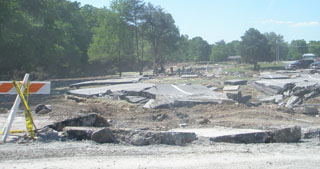 houses on that street that were completely washed away. About a mile further down 249 revealed that the elementary school had been under several feet of water, as was evidenced by the brown water line on the building and surrounding trees.
houses on that street that were completely washed away. About a mile further down 249 revealed that the elementary school had been under several feet of water, as was evidenced by the brown water line on the building and surrounding trees.
In Bellevue, just a few miles away from some neighborhoods that were almost completely destroyed, I stand in front of the water damaged kempo studio adjacent to the movie theater that has also been breached. In front of the movie theater, a police car blocks traffic from going west on Highway 70, as a massive landslide has completely blocked the road. All of this damage I just described took place within 10 miles of my home in Pegram, and only represents a fraction of the total amount that happened in these communities, communities that are a small piece of a far bigger jigsaw puzzle that now has to be put back together.
During a phone call to my friend Logan, he informs me that Clarksville, his town of residence, is still near its peak flood stage, with many businesses and homes still underwater. He also confirmed the rumor that the wastewater treatment plant has been underwater since Monday, and with the plant inoperable, Clarksville’s sewage has been flowing directly in to the Cumberland River. In a news article, Tisha Calabrese-Benton, a spokeswoman for the Tennessee Department of environment and conservation, said a number of facilities upstream have been shut down as well. On the local evening news, I also learned that several counties are in a state of water emergency, as many water treatment plants have been damaged. Officials warn that while conservation efforts are underway, a stronger effort is needed.
Many that live in Tennessee, as well as other parts of the South, are always on the lookout for severe weather, with more people probably watching for tornado outbreaks than anything else. What I find most disturbing about this event was that this incomprehensible amount of damage was inflicted from a rainstorm. Even the most severe tornado outbreaks ever experienced in Tennessee pale in comparison to the amount of damage inflicted, and the total area affected by this rain event, an event that truly underscores the unyielding power of what a rainstorm can do.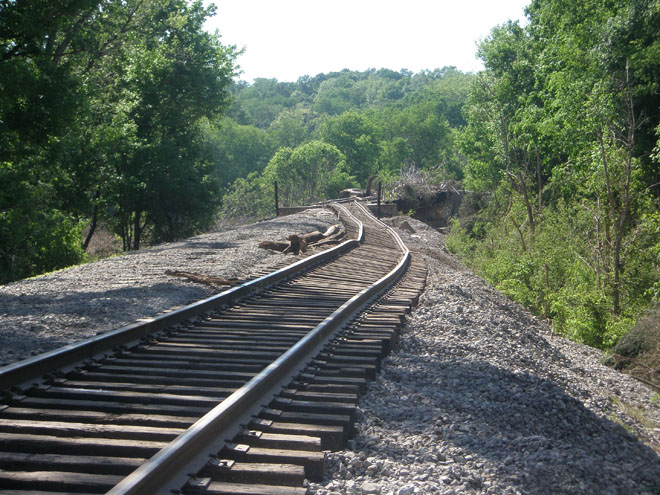
It’s now Tuesday morning, May 4th, and the local news is announcing that while the Cumberland River in downtown Nashville has crested with the waters now receding, Ashland city and 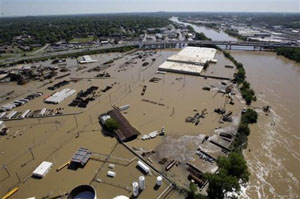 Clarksville are still at flood stage. Several city blocks in downtown Nashville are now without power as basement vaults are flooded. A caller on the morning news explains that their location, Pinnacle Hill in Kingston Springs, is a hilltop community that is still inaccessible, and that there are many families running out of food, with some in need of medical attention. There is water in the basement of the Opry House and the Country Music Hall Of Fame, both of which contain irreplaceable archives and memorabilia. Another news story shows a business owner standing in front of a sea of tractor-trailers trucks, his livelihood of 31 trucks and hundreds of trailers underwater and destroyed. Other video footage reveals roadways with damage that would otherwise be associated with an earthquake. The Opryland hotel, which accounts for 1/5 of the available hotel rooms in Nashville, announces it will be closed for months, inevitably leaving hundreds, if not thousands jobless. Hard-hit communities across the state share similar tragic tales ranging from loss of life to power outages, impassable roadways to pending water shortages, and homes and businesses either being damaged, destroyed, or completely washed away.
Clarksville are still at flood stage. Several city blocks in downtown Nashville are now without power as basement vaults are flooded. A caller on the morning news explains that their location, Pinnacle Hill in Kingston Springs, is a hilltop community that is still inaccessible, and that there are many families running out of food, with some in need of medical attention. There is water in the basement of the Opry House and the Country Music Hall Of Fame, both of which contain irreplaceable archives and memorabilia. Another news story shows a business owner standing in front of a sea of tractor-trailers trucks, his livelihood of 31 trucks and hundreds of trailers underwater and destroyed. Other video footage reveals roadways with damage that would otherwise be associated with an earthquake. The Opryland hotel, which accounts for 1/5 of the available hotel rooms in Nashville, announces it will be closed for months, inevitably leaving hundreds, if not thousands jobless. Hard-hit communities across the state share similar tragic tales ranging from loss of life to power outages, impassable roadways to pending water shortages, and homes and businesses either being damaged, destroyed, or completely washed away.
Amidst the disaster are a couple of rays of hope. The weather forecast predicts clear sunny days for the rest of the week, with only a slight chance of rain on Friday. Calls for volunteers are also being answered with thousands of people chipping in to help with the recovery process. A televised press conference in the middle of 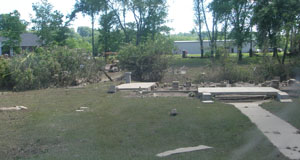 the day presents a steady stream of officials, each making announcements pertaining to specific areas of disaster relief. While the officials did provide much useful information, evidence of an overall lack of preparedness, organization, and communication is revealed, as the website they direct citizens to for disaster relief, Tennessee.gov, had not been updated since Sunday afternoon, and contained outdated information. One city official announced that floodwaters are unsafe and may contain raw sewerage, chemicals, and unknown dangerous objects, and to stay out of the water. A short while later another news story showed children playing in the water, and an adult attempting to water ski through floodwaters behind a pickup truck.
the day presents a steady stream of officials, each making announcements pertaining to specific areas of disaster relief. While the officials did provide much useful information, evidence of an overall lack of preparedness, organization, and communication is revealed, as the website they direct citizens to for disaster relief, Tennessee.gov, had not been updated since Sunday afternoon, and contained outdated information. One city official announced that floodwaters are unsafe and may contain raw sewerage, chemicals, and unknown dangerous objects, and to stay out of the water. A short while later another news story showed children playing in the water, and an adult attempting to water ski through floodwaters behind a pickup truck.
Upon calling a few friends that lived in neighboring communities, I learned the fate of a few other areas less covered by the news. One friend in Kingston Springs informed me that five or six houses had been completely washed away on his street. Another told his tale of driving home from a friend’s house with his three-year-old daughter on Saturday night, when a foot of water came rushing across the road and swept his vehicle to the side, stalling his vehicle. After 20 harrowing moments stuck in the rushing water, they were able to return to their friends house where they stayed until Tuesday, at which point they discovered a mile and a half hike 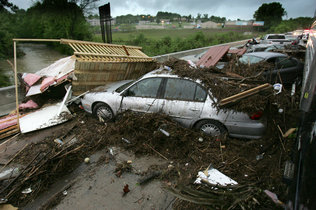 was now required to get to their now in accessible home in White Bluff which sat intact right next to a neighbor’s house that was completely washed away.
was now required to get to their now in accessible home in White Bluff which sat intact right next to a neighbor’s house that was completely washed away.
A little later, a news story announced that the army corps of engineers was releasing water from the areas dams at strategic intervals. Throughout the day, I periodically switched from local news to national media stations such as CNN, MSNBC, Fox, and other national news programs, and was thoroughly disturbed to see the Tennessee flood getting little to no coverage. By mid afternoon, the CNN website used a small portion of this event as the lead story. Barely scratching the surface, the info put forth implied this storm mainly affected Nashville, when the reality is that it has impacted hundreds of thousands of people over thousands of square miles With the loss of life is in the dozens, the economic and infrastructure damage , however, will likely be in the billions, as this storm system has produced catastrophic damage not only across much of Tennessee, but in the neighboring states of Mississippi, Arkansas, and Kentucky.
This monumental 500 to 1000 year event, came with little warning. Unlike Hurricane Katrina, which first made its introduction days in advance by way of big scary radar images on radar, this storm looked like a typical round of heavy rain and severe weather. No one could have known the system was going to stall right over Tennessee. Nevertheless, it did, dumping between 12 and 20 inches of rain, 28% of our annual rainfall, in less than 48 hours. And while it doesn’t have the dramatic buildup, high death toll, and scenes of looting, this event is potentially as ever far-reaching in terms of human suffering due to a natural disaster. While the local news of middle Tennessee has provided much coverage so far, most of this coverage has been for Davidson County, with minimal attention to the rest of Tennessee. The national news media has completely missed this epic disaster, with a few slight exceptions. While the oil slick off the gulf of Mexico, and the New York City car bomber, are certainly important stories, they are not the only stories. In the age of 24 hour news media coverage, there is no excuse for this kind of ineptitude and shortsightedness. Where are all the journalists hiding, for they have missed the quiet Katrina. 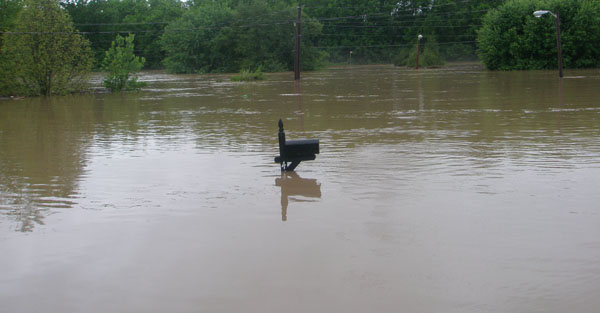
It’s now early Monday morning, day three of this epic event, and I awoke to a dark house, as we were still without power. Living in this world of constant connectivity and electric powered amenities allows for a lifestyle that we take for granted, even breeding complacency and cockiness in our falsely perceived roles as masters of the universe. As of this moment, the word vulnerable and insignificant doesn’t even begin to describe the feeling of being trapped in your own neighborhood with all access roads cut off, no electricity, no Internet, and information coming only by radio, and others caught in the same predicament.
Starved for information, and needing some supplies we decided to reinvestigate the condition of the roads. After a quick visit to the main entrance revealed the main road was still under water, we slowly and carefully proceeded north on the only other main access road, 249, to Ashland City. It was a warm day, and the sun was now shining, giving the illusion for a brief moment that nothing was wrong outside of our development. This all changed when we saw some damage in the form of fallen trees, and scattered debris in the mud of some low-lying areas.
This particular road is not unlike many in middle Tennessee; rolling hills covered with thick forests, fields and pastures speckled with a 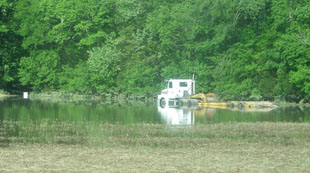 few random cows and horses, sparsely scattered houses, and a few small family farms here and there. After about 10 minutes of driving on this road, we came to an area that was void of housing for a few miles, and an eerie feeling set upon us as a large desolate lake appeared to our right, butting right up to the road. Our concern quickly escalated when it became obvious that this lake was brand-new, and probably a field a couple of days ago, as we could see the roof of a submerged tractor-trailer truck cab near the distant shore. No sooner had we spotted the sunken truck, when the now horrifying view through the windshield was that of this new lake completely surrounding the road, with the pavement disappearing about 100 feet in front of us. The straight flat highway of asphalt ahead looked like an ominous runway off the edge of the earth. With water on both sides of the road up to the painted white lines, I carefully executed a three-point turn on this death road to hell, and drove back to our home.
few random cows and horses, sparsely scattered houses, and a few small family farms here and there. After about 10 minutes of driving on this road, we came to an area that was void of housing for a few miles, and an eerie feeling set upon us as a large desolate lake appeared to our right, butting right up to the road. Our concern quickly escalated when it became obvious that this lake was brand-new, and probably a field a couple of days ago, as we could see the roof of a submerged tractor-trailer truck cab near the distant shore. No sooner had we spotted the sunken truck, when the now horrifying view through the windshield was that of this new lake completely surrounding the road, with the pavement disappearing about 100 feet in front of us. The straight flat highway of asphalt ahead looked like an ominous runway off the edge of the earth. With water on both sides of the road up to the painted white lines, I carefully executed a three-point turn on this death road to hell, and drove back to our home.
I went over and spoke to one of my neighbors about the road conditions we had just experienced, and he informed me there was one access road open. The road had some problems and required some detailed directions as there were many turns, but it was passable, so we decided to make a second attempt. Along the way we saw a large section of a hill that abutted 249 had ripped away, so we pulled over to make sure the road was safe. The stunning view over the guardrail was that of a hill that looked like it had a large bite taken out of it, with uprooted trees and brush strewn about like matchsticks more than 100 feet below. We carefully retreated to our car and cautiously proceeded past this weakened part of the road on the opposite side.
After a long drive through the winding maze of obscure back roads, we safely emerged near the Wal-Mart on Charlotte Pike. Our newly revised mission was to fill up our car with gas, purchase some ice, dry foods, and water, and find an Internet café. A phone call from our neighbor notified us that the electricity was finally back on, so we skipped the Internet café and returned home. It was now Monday early afternoon, and we were finally getting our first viewings of the totality of the destruction this historic flood was unleashing throughout the state on local news television.
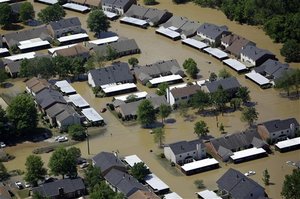 Some of the first images we saw reminded me of aerial pictures of damage caused by Hurricane Katrina; subdivisions containing hundreds of homes submerged under water almost to the rooftops, submerged vehicles stranded on roadways, mounds of debris, and cars stacked in piles like toys. We remained glued to the television throughout the day as new information and stories were developing exponentially. At some point in the afternoon, it was announced that the Opryland hotel was under 10 feet of water, and that 1500 guests had to be rescued. The entire area around the Opryland hotel including the Opry House, the Opry Mills Mall, and a parking lot in which our cars had been parked just 36 hours before were under 5 to 10 feet of water. Parts of downtown were being evacuated as water was now up to second avenue near Riverfront Park. Suburbs like Antioch, Bellevue, Old Hickory, and many others had homes, schools, and businesses
Some of the first images we saw reminded me of aerial pictures of damage caused by Hurricane Katrina; subdivisions containing hundreds of homes submerged under water almost to the rooftops, submerged vehicles stranded on roadways, mounds of debris, and cars stacked in piles like toys. We remained glued to the television throughout the day as new information and stories were developing exponentially. At some point in the afternoon, it was announced that the Opryland hotel was under 10 feet of water, and that 1500 guests had to be rescued. The entire area around the Opryland hotel including the Opry House, the Opry Mills Mall, and a parking lot in which our cars had been parked just 36 hours before were under 5 to 10 feet of water. Parts of downtown were being evacuated as water was now up to second avenue near Riverfront Park. Suburbs like Antioch, Bellevue, Old Hickory, and many others had homes, schools, and businesses 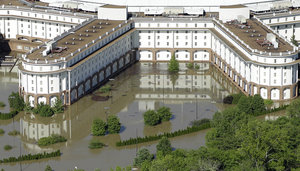 underwater, bridges and parts of roads washed away, and people being rescued from their homes and businesses by boats.
underwater, bridges and parts of roads washed away, and people being rescued from their homes and businesses by boats.
The flood was impacting areas far beyond the city limits, as the Cumberland River was well beyond flood stage in Clarksville. One newscaster made the frightening announcement that problems in a water treatment plant might cause for raw sewerage to be dumped into the Cumberland River there. Power outages were widespread, Interstates were experiencing closures due to flooding, and President Obama began the process of declaring disaster areas in over 50 counties spanning almost half the state.
Signs of being ill-prepared for a natural disaster of this magnitude started to become visible as video showed children and adults playing in floodwaters despite the occasional newscaster warning that the waters can contain sewerage, chemicals, and dangerous objects. Some of 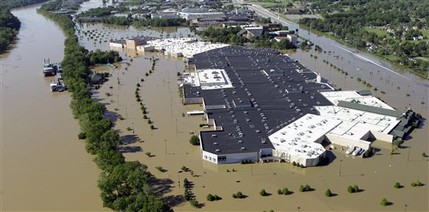 the flooding downtown was being caused by one businesses ill advised attempt to pump water from its basement, and barely mentioned were city officials requests for citizens to conserve water despite water treatment and purification facilities being down. Early predictions stated that the Cumberland river wood crest by 3 PM at 51.5 feet (flood stage is at 40), but these predictions kept getting pushed back into the evening hours. The local news stations, which had done a fair job of covering the event up to this point, became an embarrassing disappointment, when the 10 PM broadcasts showed rebroadcasts of events from earlier in the day, delivering no new news as to whether or not the waters were still rising or receding.
the flooding downtown was being caused by one businesses ill advised attempt to pump water from its basement, and barely mentioned were city officials requests for citizens to conserve water despite water treatment and purification facilities being down. Early predictions stated that the Cumberland river wood crest by 3 PM at 51.5 feet (flood stage is at 40), but these predictions kept getting pushed back into the evening hours. The local news stations, which had done a fair job of covering the event up to this point, became an embarrassing disappointment, when the 10 PM broadcasts showed rebroadcasts of events from earlier in the day, delivering no new news as to whether or not the waters were still rising or receding.
Physically and mentally drained, we decided to retire for the evening. Feeling relatively safe from the floodwaters on our hilltop haven, I can still barely comprehend all that’s happened over the past three days, and I still have feelings of anxiety and confusion. This disaster is far from over, and I’m sure that the tale of the great Tennessee flood of 2010 is just beginning.
In light of the recent flood disaster that has decimated middle Tennessee, I feel compelled to put my music industry blogging on hold temporarily as I feel this developing story is much more pertinent. As some of you may have read in my last two blogs, my family and I have lived through this catastrophe, and while we are okay, our state of Tennessee is being widely impacted with the complete repercussions of this event far from over. In the coming weeks I will continue to write about any Rhett Akins shows as they happen, as well as anything else interesting that happens within my musical endeavors, but at least for the immediate future, I plan to keep most of my writing geared towards this unfolding disaster.
It was just after noon on Sunday, May 1st, and the electricity was still down when we turned on our battery-powered weather radio. Now day two of the heaviest rainstorm we had ever seen, me, my wife Kelly, and our son Josh sat around the living room amidst an ambience of perpetual twilight, and listened to the computer-generated voice of Noah Weather Radio deliver a frightening and unsettling story. Round two of this marathon downpour had began in the early morning hours and was now causing many rivers across the state to reach flood stage. We were rendered speechless as this digital weatherman went down the list of where the different rivers in the different counties were about to, or already cresting, with the Harpeth River, about a half mile from our house in Pegram, Tennessee, among them. The list of road closures was also statewide, and hearing all of this news while sitting without electricity and in near darkness, seemed ever more ominous, as the voice telling the story was not unlike that of the Terminator, and void of all emotion.
I made a call on my cell phone to the power company, at which point I learned that the outage was widespread, but not much more. Unknowing of the duration of this storm event or the 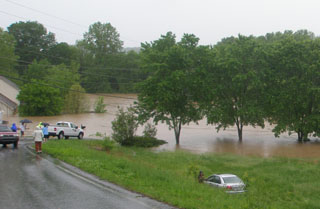 power outage, it was now time to take stock in our situation. We grabbed everything out of the refrigerator that could make for some cold meals; sandwich stuff, bread, cheeses, peanut butter, juice, and beer, and put it in a cooler with the remaining ice from our freezer. A house-wide search was conducted for all available flashlights, batteries, candles, matches, and board games. Confident that we were now set for a few days , I decided to walk next door and talk to my neighbor to see what he knew about the situation. He told me that the road at the bottom of our development hill is underwater, and that several houses in that area had been flooded. My mind struggled to comprehend his words, which seemed to just hang in the humid spring air, and this prompted further investigation as I just couldn’t visualize, and didn’t want to believe what I just heard.
power outage, it was now time to take stock in our situation. We grabbed everything out of the refrigerator that could make for some cold meals; sandwich stuff, bread, cheeses, peanut butter, juice, and beer, and put it in a cooler with the remaining ice from our freezer. A house-wide search was conducted for all available flashlights, batteries, candles, matches, and board games. Confident that we were now set for a few days , I decided to walk next door and talk to my neighbor to see what he knew about the situation. He told me that the road at the bottom of our development hill is underwater, and that several houses in that area had been flooded. My mind struggled to comprehend his words, which seemed to just hang in the humid spring air, and this prompted further investigation as I just couldn’t visualize, and didn’t want to believe what I just heard.
Our house sits in the middle of a development near the top of a big hill, at least a hundred or so feet above the road below, and just a stone’s throw from the Harpeth River, one of several major rivers that snake through the valleys of middle Tennessee. As we neared the main entrance, the scene that came into focus was beyond words. Still raining heavily, we viewed the entrance to our development, and saw the top couple inches of a stop sign poking up out of the brown water from about 40 feet away, which was the closest we could 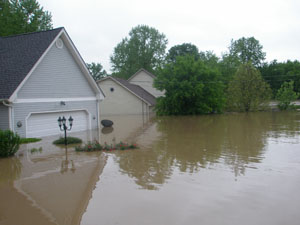 get to the main street, now a lake spanning more than 100 feet across. To the left of the entrance, stood two beautiful two-story homes, now submerged in water that almost reached the second floor. To the right of the entrance, “Lake Harpeth” stretched as far as the eye could see, with several homes formally abutting the road now inaccessible and cut off, achieving an unwanted beach front status.
get to the main street, now a lake spanning more than 100 feet across. To the left of the entrance, stood two beautiful two-story homes, now submerged in water that almost reached the second floor. To the right of the entrance, “Lake Harpeth” stretched as far as the eye could see, with several homes formally abutting the road now inaccessible and cut off, achieving an unwanted beach front status.
After a few minutes of taking in the eerie site, this natural disaster that was now a half mile from our home, we retreated to our safe haven on top of the hill. A few hours later the rain finally stopped, and we took a drive to check out one of the two other access roads. We didn’t get too far before we spotted another city truck blocking the road, and the impact of this flood was becoming more clear with each passing minute. From this new vantage point, we could see our community bank completely submerged, water 6 feet high, and above the windows. A brief chat with a city worker informed us that the garage next door was underwater, and that some people had to be rescued 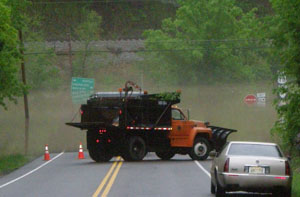 from the gas station by boat a little earlier in the day. We also learned that the power substation was underwater, and would require the floodwaters to recede before it could be assessed. After a few minutes of taking some pictures and video, we solemnly returned to our home.
from the gas station by boat a little earlier in the day. We also learned that the power substation was underwater, and would require the floodwaters to recede before it could be assessed. After a few minutes of taking some pictures and video, we solemnly returned to our home.
We sat around the living room listening to the radio for news, as the darkness of night grew near. As we had no way to charge our cell phones, we stayed off them, reserving their power for as long as possible. We ate a little food, drank a few beers, and played a game of Scrabble to pass the time, but the mood was still a bit less than cheerful. In a typical power outage, one experiences minor inconveniences; a lack of the basic amenities normally taken for granted. But when the power goes out and you are stranded by way of a natural disaster, the feeling is much more of panic. Information becomes a commodity, as you struggle to gain perspective on your life situation. In an event of this proportion, without electricity, we lose almost all connection with the outside world, and are deemed naked and vulnerable, prisoners within our own homes. I hope the water recedes soon, and the power comes back on so we can reconnect with the outside world. Meanwhile, safe from the waters below, but cut off from what lies beyond, we wait, marooned on Pegram Island.
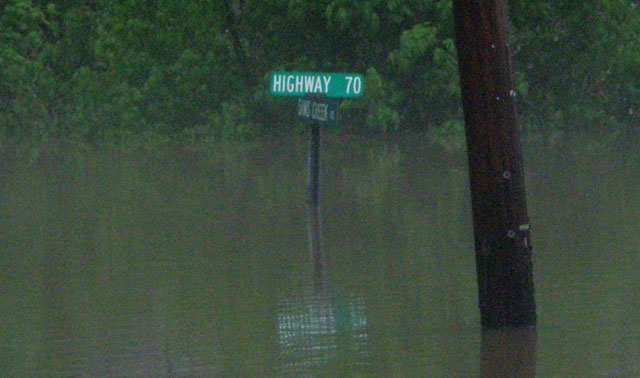
Saturday morning began for me at 5:30 AM, when I was suddenly awoken by the sound of a loud crack of thunder. By the time I dragged myself out of bed a short while later, a heavy downpour was underway, and our fair state of Tennessee was beginning to receive a walloping storm. On any other day this would have been less significant for me, but on this first day of May, 2010, Rhett Akins and band were leaving for an outdoor show in Alabama, and it was my job as tour manager to see it through.
All morning long, in between preparing for the trip, my wife Kelly and I kept checking the weather, and grew more concerned with every passing minute as the forecast was not good. During the 40 minute drive to the bus, which was exceptionally precarious due to the now torrential rain, I received a call from Rhett, who informed me he would be leaving late and driving himself to the show. We arrived at the bus, loaded up, and began the 130 mile drive to our destination, the small town of Hartselle, Alabama, just a little ways over the Tennessee/Alabama border.
The rain was relentless for the first half of the drive, and just when it seemed like our show was doomed, it gradually began to subside as we neared the Alabama border. I now received my second phone call from Rhett, and our newly found optimism was again put on hold when he told me that he just saw a car completely submerged underwater on the northbound side of Interstate 65. We all began to worry about our fearless leader (as well as our own fate) as we watched the news now showing video footage of the devastation this storm had just wreaked upon Arkansas, in the form of tornadoes, and Memphis, by way of flooding.
We safely arrived to our destination, a large open field in the middle of nowhere upon which a local business, Frederick Tractor Supply, was throwing a groundbreaking ceremony. As we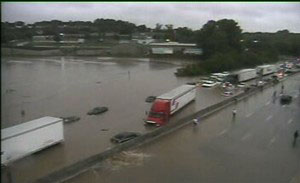 pulled down the long gravel driveway, I first spotted the stage; two flatbed trailers complete with a green tarp “awning”, supported by two by fours. I now received my third call from Rhett who informed me that the radio stations were no longer playing music, but delivering storm news, and that I65, I24, and I40 around Nashville were now closed due to flooding. A short while later I was greeted by the owner who told me “I think we may have dodged a bullet on this one.” as I felt a few light rain drops on my face.
pulled down the long gravel driveway, I first spotted the stage; two flatbed trailers complete with a green tarp “awning”, supported by two by fours. I now received my third call from Rhett who informed me that the radio stations were no longer playing music, but delivering storm news, and that I65, I24, and I40 around Nashville were now closed due to flooding. A short while later I was greeted by the owner who told me “I think we may have dodged a bullet on this one.” as I felt a few light rain drops on my face.
The light sprinkle was short-lived, and we hesitantly began our load in and soundcheck. Halfway through soundcheck the sprinkle returned and intensified, so we covered our gear and returned to the bus. Around 5:30 it subsided, and we finished soundcheck and waited for dinner, some home-cooked barbecue that was allegedly “the best in the county”. As we sat on the bus, the latest news reports were now showing a broader picture of the pending apocalypse that loomed just outside our door step. Flipping between the Weather Channel and CNN, we were horrified to see images of Nashville interstates that looked more like lakes filled with half submerged cars and tractor-trailers, viewed through a gloomy mist of grey.
It seemed surreal that we were getting ready to play a concert, while just 100 miles to our north there were more than 70 cars underwater 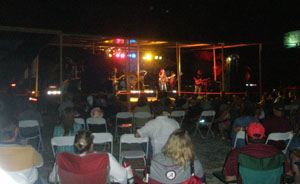 on the roadways we had just traveled upon. Strangely enough, it never did rain again on our quaint little country setting, and we played a 90 minute show to an approving audience of 500 or so tractors and concertgoers.
on the roadways we had just traveled upon. Strangely enough, it never did rain again on our quaint little country setting, and we played a 90 minute show to an approving audience of 500 or so tractors and concertgoers.
After the show was over, our bus driver Steve informed us that I65 was now passable, but that another round of storms was on its way, so we made a hasty departure to try to beat the next storm. Fortunately, the ride home was uneventful, and we arrived safely back to our cars in a parking lot near the Opryland Hotel. A short while later, as Kelly and I neared our home just West of Nashville, we came upon a city truck blocking the road in front of some standing water, and had to take a detour to a secondary entrance to our development. As we pulled into the driveway of our home, we were greeted by a cold dark house as the storm had knocked out the power in our area.
It’s now noon the next day, again raining heavily, and I’m writing this by hand as we’re still without power. We learned the day before that a flood watch will be in effect for middle Tennessee until Thursday, as this storm was not yet finished. Yesterday it rained 11 inches and less than 10 hours, and before the storm is done, we could receive up to 4 to 8 inches more. So far at least eight people have died from drowning in what is being deemed the worst flooding the state has seen in over 30 years.
It’s not over yet, and I wonder what we’ll learn when the power comes back on. As I sit with a pen and paper, looking through a window at a rain soaked canopy of green and grey, I’m still amazed at how a mere 14 hour bus gig, the shortest in recent years, was one of the most stressful and terrifying we had ever experienced. While some weren’t so lucky, at least for our group, it looks like we might have dodged a bullet on this one.
This day began like so many other days on the road, waking up on a tour bus to the view a hotel parking lot in the middle of nowhere. On this particularly warm spring day we were scheduled to play a multi-band extravaganza in Vienna Georgia, and after a couple of hours at the local Country Inn and suites, we set off to the concert site on other side of town. As we pulled down a long dirt road, the view of the “Pig Jig” festival grounds came into focus. An array of crudely built, weathered shacks and buildings that kind of reminded me of a movie set that fell somewhere between an imaginary western and a redneck Ewok village.
Upon our landing, I was greeted by Mack, the festival promoter, who direced some stage hands to unload our gear. I walked over to check out the stage, a large outdoor “shed” style structure in which Colt Ford and his band had just finished their soundcheck, and helped guide our gear into place. A couple hours later, after our soundcheck, I organized a hotel run for the band to get some showers and downtime. When we returned to the concert grounds around dinner time, there was already a good size crowd building, and some of our group retreated to the hospitality area for some “pig and fixin’s”.
The concert begins with a local acoustic duo, RDR, who slowly began to wake up the crowd, now sweltering in the hot Georgia sun. Sonny Ledfurd, a three piece band from North Carolina, was up next, and the crowd seemed to really get into the bands tunes about drinking whisky, smokin’ dope, and “partying in my driveway”. Tyler Farr (from Colt’s band) then played a brief acoustic set just prior to our show, and the crowd was now thoroughly primed for Rhett and band. With the darkness of night now upon us, the mood was just right, and we launched into our 60 minute show of rockin’ southern country. The crowd responded warmly to some of Rhetts’ earlier hits as well as some newer material like “My Baby Looks Good in Camouflage” and “Duck Blind”. We finished our set with Rhett’s anthem “Kiss My Country Ass”, tore down our gear, and move it to backstage to wait for stagehands.
Upon spotting one of the stagehands backstage I instructed him to round up a few more hands to help deliver the gear to the bus. When 2 more husky fellows arrived a few minutes later, the first load of gear was delivered to our bus, after which the “hands” seemed to vanish into thin air. After another 5 minutes or so I call the promoter and “re-request” the stagehands. A minute later, one of the hands returned ahead of his co-workers and proceeded to walk right past me and the gear to briefly vomit around the corner. Our drunken helper returned and exclaimed “O.K., what’s next?” The other hands returned, we finished the load-out, and then we were done for the night. A few minutes later Colt took the stage with his band to rock the 1000 or so in attendance. A little while later and we we’re driving off into the night to our next destination, “The Clubhouse at Rye Patch” in Ludowici, GA. We we’re all exhausted, but it was a fun day, and the show went well. In the end, fun was had by all at the Big Pig Jig.
Nashville Tennessee remains a prime destination for many musicians, songwriters, artists, and industry professionals, and in light of the city’s unique musical heritage, this constant influx will unlikely stop anytime soon. But beneath the suggestive title of “Music City” is a place that for many newcomers might be more aptly titled “Mystery City”. For in reality, the Nashville music scene is a massive, diverse, competitive, and ever-changing community whose true scope and nature are near invisible to those not working within it. Becoming one of the few fortunate musicians to find work and acceptance within this community can be a formidable task, and even when those goals seem to have been achieved, sustaining that career long term can be just as challenging, as I have learned first-hand.
My Nashville adventure began like many transplants to Music City, a cross-country pilgrimage with a U-Haul full of belongings, some life savings, big ideas, and no clue about what I was getting myself into. That first year of 2002 would prove one of the hardest, with my wife and I both trying relentlessly to find employment, struggling to pay the bills, and earning the bulk of our income by selling off possessions on eBay while going out on the town at night to network. About one year into this new life, the networking paid off, and I landed a job as a guitar tech on the Toby Keith 2003 Shock ‘N Y’ all tour, a true financial lifeline. I have spent most of my years since that tour working for country music artist and songwriter Rhett Akins as tour manager, band leader, and lead guitarist. Along the way I have, and continue, to work some in-town club gigs and recording sessions and I still panic trying to pay the bills every winter when the touring season slows to a crawl. Overall, I am earning a living from music and I credit this good fortune to having an invaluable combination of skills, work ethic, and a friend in the music community who pointed me in the right direction.
This kind of good fortune is not the case for all who venture to Music City, and along my journey I have met many struggling musicians and artists who have had much harder luck. At a recent blues jam, I met a drummer who had been in Nashville for about a year. He had done a couple of gigs in town, but nothing consistent, and nothing that came close to paying any bills. He was doing his best to try to insert himself into the scene but wasn’t having much success. “How do you get a road gig, or any gig in this town for that matter?” he asked. I could see the look of desperation in his eyes as he told me that his savings were now all used up and he wasn’t sure what he was going to do next.
Unfortunately, this kind of story is far more common in Nashville.
That conversation, as well as other similar tales, led me to the realization that the world outside of the Nashville music community knew very little of its inner workings, and that there is a real need for this information to be available to the masses. What originally began for me as a series of blogs and message board postings has now evolved into the soon to be completed book “The Nashville Musician’s Survival Guide” with its companion website www.survivenashville.com. Written from my perspective of being a working musician, the book outlines the structure and potential jobs within Nashville’s recording, touring, and nightclub communities. The basic job requirements, pay scales, and networking required to land those jobs are explored in great detail. Additional perspective in the form of several recent and ongoing interviews with music professionals will also be put forth, including A-list session bassist Mike Chapman, self-made indie artist Colt Ford, touring musicians, nightclub musicians, club owners, songwriters, engineers, managers, bus drivers, and more.
Nashville is a funny place. Everybody comes here to fulfill their dreams in music but most are unable to survive for any real length of time. Many of those who do survive long-term end up so trapped in the business end of things that their musical integrity often suffers. It seems that for many people, the Nashville experience isn’t what they hoped it would be. The key to surviving Nashville is to have a clear vision about your long-term goals, find different ways to earn income working within the current music scene while working towards those long-term goals, and use your relationships and connections from within the music community for financial survival and to achieve your long-term goals. None of this can be accomplished without some knowledge about the current state of the Nashville music community, a long-term commitment to this place and without building real, lasting relationships. It is my hope that this book and website will help some to accomplish their dreams.
In the meantime, good luck on the path.
Since first moving to Nashville in 2002 I have worked on several national tours, and for the most part, have had the luxury of traveling around on Prevost XLII tour buses, the luxury liners of touring. In my opinion, traveling by tour bus with a professional driver is, by far, the most comfortable and stress-free way to travel long distances with a group. Many musicians, past and present, are not so fortunate, and for some, “vanning it” is the only option. At a few different points during my touring years, I too have wound up in that category.
A couple of years into my life in Nashville, I played a handful of gigs with a regional cover rock band. On one particular weekend, we were hired to play at a biker party on top of Fredonia Mountain, a remote area far from civilization as we knew it, near the Tennessee-Alabama border (think Deliverance). Kelly and I left Nashville early afternoon driving in, you guessed it, a van (our trustworthy 2001 Dodge Caravan), loaded with my guitar equipment, a bag lunch, and some sleeping bags, as we were planning to sleep over after the show. The majority of the 130 mile drive was on Interstate 24, and we made it to our exit in just under two hours. The last 20 or so miles of the trip were on backroads, winding through hilly terrain, with a couple of small towns occasionally popping up out of nowhere. Keep in mind that this took place just prior to the era of affordable GPS technology, so we were relying on our printed out directions from Microsoft’s “Streets and Trips” to guide us.
After driving around for about an hour, unable to find the access road to the mountain, we realized we were lost, and stopped at a convenience store to ask directions. There were two guys standing outside their pickup truck in the parking lot, and upon asking them how to get to Fredonia Mountain, they answered in a dialect of hick that was so far removed from the English language it might as well have been Klingon. At this point, now afraid to step outside of our van again, we realized we were on our own, and began to backtrack using our printed out directions. After taking a series of turns onto, what the directions labeled as “local roads”, we turned down one particular gravel road that, at first, seemed like the most logical access point to the mountain. As this gig was on top of a mountain, and we were driving on mountain roads, with the directions literally reflecting each new turn we took, we had no reason to think we were on the wrong track. 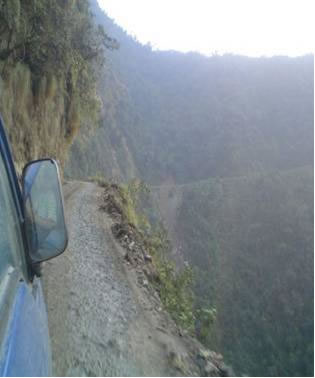 Any thoughts of such certainty quickly vanished when the gravel road upon which we were traveling emerged from the forest allowing us a horrifying view of reality. Kelly, who had been driving up to this point, stopped the van suddenly when we saw out of the driver’s side window, a sheer drop off about 3 feet to the left of the van. The view out of her window was that of treetops a couple hundred feet below us, and with the road being deeply rutted and on a downhill slope, we couldn’t back out of this predicament.
Any thoughts of such certainty quickly vanished when the gravel road upon which we were traveling emerged from the forest allowing us a horrifying view of reality. Kelly, who had been driving up to this point, stopped the van suddenly when we saw out of the driver’s side window, a sheer drop off about 3 feet to the left of the van. The view out of her window was that of treetops a couple hundred feet below us, and with the road being deeply rutted and on a downhill slope, we couldn’t back out of this predicament.
Already a mile or so down what was obviously an old logging trail, and no longer in cell phone coverage, we had no choice but to continue forward, in the hopes that this road might bring us to our destination. I got out and walked ahead of the van, slowly helping to guide Kelly through this dangerous section of road. After a few hundred feet, the drop-off section now passed, I hopped back in the van and we continued driving down this trail. Another mile or so of slow-going on this rough terrain and the dirt road became suddenly blocked by some fallen trees, making it obvious that we were going to have to turn around. Kelly, who was now in a near state of panic with dusk approaching, asked me to make the drive out. As there was no place to turnaround on this dead-end road into hell, I backed the van up for about a half mile to a spot that would allow a six-point turn. One more panic stricken ride past the lookout of death, and we emerged safely out of the forest.
We eventually made it to our gig (somewhat late), and as is it turned out, this logging trail brought us to within 5 miles of it. Unfortunately, the Microsoft provided directions, while bringing us to the base of the mountain, failed to show the dangers of these “local roads” and that the only safe access road was about 30 miles around the other side of the mountain. I wish we had a camera with us on that day, as our view out the van window of the valley of death was beyond words. The near perilous experience we lived through on that unforgettable day did teach us some valuable lessons we will never forget. Don’t ever completely rely on a Microsoft program to get you safely from point A to point B, always be suspicious of anything labeled “local roads”, avoid asking locals for directions whenever possible, and, always beware of the pitfalls of “vanning it”.
